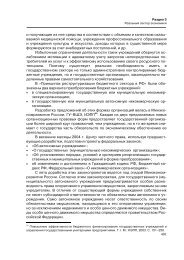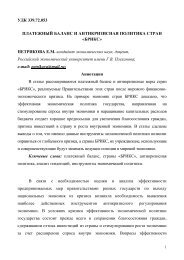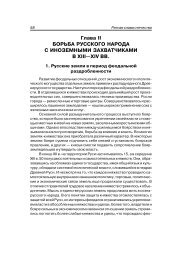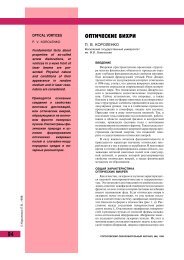Ensuring Strategic Stability in the Past and Present:
Ensuring Strategic Stability in the Past and Present:
Ensuring Strategic Stability in the Past and Present:
You also want an ePaper? Increase the reach of your titles
YUMPU automatically turns print PDFs into web optimized ePapers that Google loves.
ut cause serious concern <strong>and</strong> anxiety <strong>in</strong> <strong>the</strong> Soviet Union—a consequence that was not explicitlyspecified <strong>in</strong> <strong>the</strong> official public documents of <strong>the</strong> Reagan Adm<strong>in</strong>istration. However, <strong>the</strong> SovietUnion had good reason to direct its top government experts <strong>and</strong> academic <strong>in</strong>stitutions to carryout <strong>in</strong>-depth studies of plans by <strong>the</strong> U.S. to develop its strategic forces. The very idea of <strong>the</strong> U.S.achiev<strong>in</strong>g military <strong>and</strong> technological superiority over Russia became <strong>the</strong> context <strong>in</strong> which Moscowconsidered <strong>the</strong> SDI program put forward by Reagan.This was a time when <strong>the</strong> threat of <strong>the</strong> arms race <strong>in</strong> outer space became feasible aga<strong>in</strong>, as a resultof <strong>the</strong> creation of anti-satellite weapons on a new technological basis, <strong>and</strong> both sides were readyfor such a race. This threat could emerge much earlier, before <strong>the</strong> creation of any large-scaleanti-missile defense system as a result of R&D under <strong>the</strong> SDI program. Practically any means ofanti-missile defense— even ground-based <strong>in</strong>terceptors armed with both nuclear <strong>and</strong> non-nuclearwarheads—is also by default an anti-satellite system. Hitt<strong>in</strong>g satellites that are fly<strong>in</strong>g <strong>in</strong> predictable<strong>and</strong> known orbits is much easier than shoot<strong>in</strong>g down missiles, let alone warheads protected tosuch a very high degree that <strong>the</strong>y can avert destruction when enter<strong>in</strong>g <strong>the</strong> atmosphere.Alongside various R&D activities related to anti-missile defense <strong>in</strong> <strong>the</strong> 1980s, <strong>the</strong> United States<strong>in</strong>tensified its development of various anti-satellite systems, <strong>and</strong> similar activities were carriedout <strong>in</strong> <strong>the</strong> Soviet Union. It was less noticeable to <strong>the</strong> general public, but many experts <strong>in</strong> bothcountries clearly understood that competition <strong>in</strong> <strong>the</strong> area of anti-satellite weapons was extremelydangerous. Anti-satellite weapons could create a threat to many th<strong>in</strong>gs, <strong>in</strong>clud<strong>in</strong>g <strong>the</strong> reconnaissancesatellites that constituted <strong>the</strong> so-called “national technical means of control,” which becamean <strong>in</strong>tegral part secur<strong>in</strong>g U.S.-Soviet agreements <strong>in</strong> <strong>the</strong> area of strategic weapons. Anti-satelliteweapons would also pose a threat to <strong>the</strong> first-echelon means of missile warn<strong>in</strong>g systems (satelliteswith sens<strong>in</strong>g equipment for <strong>the</strong> detection of ballistic missile takeoffs) <strong>and</strong> to a number of o<strong>the</strong>relements of <strong>the</strong> satellite-based space <strong>in</strong>frastructure of both sides.The Soviet Union warded off those threats off by means of large-scale military, technological,political <strong>and</strong> diplomatic efforts. The conceptual, doctr<strong>in</strong>al formulation of <strong>the</strong> Soviet political <strong>and</strong>military policy of asymmetric response to SDI, which will be discussed <strong>in</strong> detail later, also playedan important role. As to <strong>the</strong> prevention of <strong>the</strong> arms race <strong>in</strong> outer space, first of all it is importantto note <strong>the</strong> unilateral Soviet moratorium on deployment <strong>and</strong> test<strong>in</strong>g of anti-satellite weapons <strong>in</strong>outer space that was announced by <strong>the</strong> General Secretary of <strong>the</strong> Central Committee of <strong>the</strong> CPSUYuri Andropov. 25It was declared that <strong>the</strong> moratorium would be <strong>in</strong> force until <strong>the</strong> o<strong>the</strong>r side refra<strong>in</strong>ed from <strong>the</strong>same activities. This moratorium rema<strong>in</strong>ed effective on a reciprocal basis until recently. It is anexample of parallel arms-race limitation measures that were not legally formalized through anybilateral treaties.In 1985, <strong>the</strong> United States conducted a test of its anti-satellite weapons, hitt<strong>in</strong>g a low-orbit satellitewith an experimental air-deployed ballistic missile called <strong>the</strong> SRAM-Altair; however, <strong>the</strong> U.S.Congress immediately blocked fur<strong>the</strong>r test<strong>in</strong>g by cutt<strong>in</strong>g off <strong>the</strong> relevant appropriations. Manymembers of both chambers of <strong>the</strong> U.S. legislative body <strong>and</strong> dist<strong>in</strong>guished experts remembered<strong>the</strong> moratorium on test<strong>in</strong>g of anti-satellite weapons declared by Andropov <strong>and</strong> considered U.S.-Soviet competition <strong>in</strong> that area to be extremely detrimental <strong>and</strong> dangerous. S<strong>in</strong>ce <strong>the</strong>n, both sidesobserved <strong>the</strong> mutual moratorium on such test<strong>in</strong>g on a no-objection basis; <strong>the</strong> moratorium was18<strong>Ensur<strong>in</strong>g</strong> <strong>Strategic</strong> <strong>Stability</strong> <strong>in</strong> <strong>the</strong> <strong>Past</strong> <strong>and</strong> <strong>Present</strong>: Theoretical <strong>and</strong> Applied Questions
















